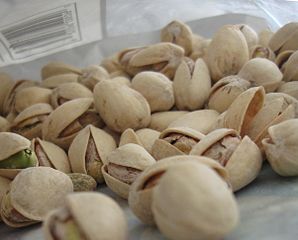|
| |
To control
cholesterol, turn to pistachios
Main
Article page |
Beauty articles
|
Health page |
Computers|
Diseases |
Education |
Entertainment |
Family
Business |Fitness|
Fruits and Vegetables
|
Jobs |
General |
Personality|
Technology
|
Tourism |
Sports
Biography Page|
Heroes & Incredible peoples
|
Inventions
|
Useful Tips
| Stories

Simple dietary changes like adding pistachio
nuts to the diet can lead to multiple health benefits
– diabetes could
be controlled, and the propensity for heart disease may be reduced in
Indians, a new study has found.
The study, the first of its kind with a trial
period of six months, was carried out by the Diabetes Foundation of India (DFI)
and the National Diabetes, Obesity and Cholesterol Foundation.
The results of the study were released Monday,
even as the prevalence of obesity and diabetes are rapidly rising in India.
Nuts (mainly pistachios, almonds and walnuts)
have been shown to have beneficial effects on glycemic and lipid parameters.
Pistachios have a low glycemic index, are
naturally cholesterol free, and are source of protein, fibre and antioxidants,
the study found.
These properties make consumption of pistachios
potentially useful for those at risk for obesity and heart disease.
“Pistachios are part of the traditional Indian
diet. However, the health effects have not been clearly understood. This study
shows multifaceted beneficial effects of pistachios suitable for the Indian body
type, for the alleviation of multiple risk factors,” said Anoop Mishra,
chairman, Fortis Centre of Excellence for Diabetes Metabolic Diseases and
Endocrinology (CDOC).
Seema Gulati, research head at the National
Diabetes, Obesity and Cholestrol Foundation, said: “Based on this study, we can
say that pistachios provide an excellent snack option, especially for those at
risk of metabolic problems and diabetes. They provide a beneficial effect in two
ways: One, by displacing energy from other unhealthy sources, and second, due to
their own intrinsic nutritional properties”.
Diabetes has taken epidemic proportions in
India, and emerged as one of the most serious healthcare problems.
( Courtesy:
Bioscholar )
Articles
| |
|



